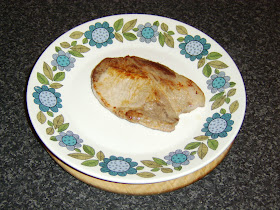Dauphinoise potatoes in their most basic form consist merely of sliced potatoes, cream, garlic and seasoning. Depending upon what I am serving them with, however, I often like to sprinkle a little ground nutmeg over the top, immediately prior to placing them in the oven. In this instance, served with a pork chop and honey glazed apple slices, the addition works very well.
Ingredients for One Person
1 pork chop
3 medium floury potatoes
2 1/2" thick slices of Bramley apple (cored)
5 fl oz double (heavy) cream (single/light cream or milk are not suitable substitutes - they will split)
2 cloves of garlic
Pinch of ground nutmeg
1 tbsp liquid honey
Salt and pepper
Sunflower oil for frying
1 medium tomato and freshly chopped dill for garnish
Method
Put your oven on to preheat to 300F/150C/Gas Mark 2. Such a low oven is necessary to prevent the cream from splitting.
Peel the garlic cloves and grate or crush them in to a bowl. Add the cream and season with salt and pepper. Stir well. It is a good idea to always have some extra cream on standby, as different dishes vary in size and the potatoes have to be all but covered.
Peel the potatoes and slice as thinly as possible, certainly no thicker than 1/4". A mandalin
When the potatoes have been in the oven for around an hour, add a little sunflower oil to a non-stick frying pan. Bring it up to a medium heat. Season the pork chop on both sides and add it to the pan. It will take around eight to ten minutes on each side to cook, depending upon the thickness of your chop. (Although there are now suggestions in certain quarters that pork can in fact be eaten slightly underdone, this is not something I am personally prepared to risk. Make sure therefore that your chop is fully and properly cooked.)
When your pork chop is done, remove it to a heated plate, cover with tinfoil and set it aside to rest for around five minutes.
Wipe your pan with kitchen towel to remove the excess oil. Add the honey and heat gently while you wash, decore and slice the apple. Do not peel it. Add the apple slices to the pan and fry for about a minute and a half on each side. You want them softened but not to the extent where they will break when you attempt to plate them.
The dauphinoise potatoes should have browned nicely on top and softened all the way through. Remove them carefully from the oven and plate them with the pork chop to one side. Add the apple slices. The tomato should be halved by making alternate forty-five degree cuts to the core around the circumference. Twist gently to separate. Scatter the dill over the potatoes and serve.
Special Feature - Brought to You by Your Coffee Mates at Roaste
Do you like to enjoy a quality cup of coffee after your dinner each night? If so, you may wish to buy coffee beans online and have them delivered straight to your door.
Yama Coffee is a gourmet coffee brand and their products are currently available on Roaste, helping you to relax and enjoy your after dinner coffee to the full. Why not check out what they have to offer today?





























